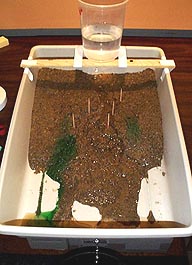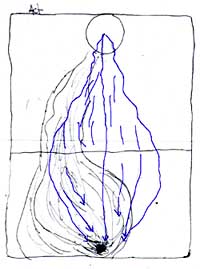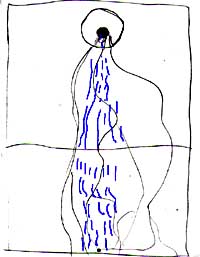|
Sand
Land
 Eek! Eek!
An underground leak!
Overview
This extension explores alternative uses of
the Sand-Land model. By injecting food color into the soil, students
can simulate the movement of a chemical contaminant in groundwater
and surface waters. The sandbox demonstration helps students visualize
the invisible-underground a part of the water cycle and can serve
as a starting point of discussions on the impact of human activities
on watersheds.
Objectives
Observe how spills on or below the earth's surface result in contaminated
groundwater, which feeds wells and springs and may eventually show
up in surface waters (rivers, lakes).
Materials
See Preparation.
Lesson Plan
Class
Setting
Students work in groups of 4 to 5 students. Each group gets one
sandbox. And each student gets one activity
card.
Script of
class interaction
Lecture
Give a short introduction on underground sources of contamination,
such as leaking tanks that store chemicals. Explain that spills
on or below the earth surface result in contaminated groundwater,
which feeds wells and springs and may eventually show up in surface
waters (creeks, rivers, lakes).
Activity
Description
Introduction
What happens when water and chemicals infiltrate into the soil?
| Activity
1: Developing a hypothesis from previous experience.
|
| Ask students
to make a drawing of what is going to happen when our food-coloring
"contaminant" is injected into the soil, and it begins to rain. |
Where is the
color going to go?
|
How does the
color interact with the sand before it rains?
|
How does the
color interact with the sand once it rains?
|
|
Think
about the dynamic systems and their relationships in our model,
before you draw.
|
| Activity
2: Investigating, running and observing the model |
- Fill
the eyedropper with liquid food coloring and stick it at
a point halfway down slope and within 1/2-1 inch from the
"stream" boundary (i.e., the stream formed by the water
flowing on the soil surface), all the way to the bottom
of the container.
- Squeeze
the food coloring out and "make it rain".
- Keep
adding water in the drip container so that the water level
remains between the and 3.5 and 4.5 minute mark, for 5 to
10 minutes (or - until you can observe food coloring running
through the hole of the pan).
- Remove
the drip container and keep on observing changes in the
size of the colored soil patch. You can also inject another
color on the other side of the stream and farther away from
the stream boundary to observe differences in the extent
of the colored area and the time it takes for the color
to spread.
|
- Reassign
team members to be a cloud, a timer, a careless person who
pollutes the ground-water and 1-2 observers.
|
Modification:
If the lesson lasts only an hour, inject the dye just next
to the stream boundary and use only one container of water.
In this way the dye will show up faster in the water in
the stream.
|
| Activity
3: Evaluating our hypothesis and investigation |
Ask
students to draw what actually happened.
|
|
Discussion
of observations:
|
How did the
contaminated area change with time?
(Where did they first see the color? How bright, how big
was the area that was visible?)
What was the final extent of the contaminated area?
How much time did it take for the food coloring to be observed
in the running water?
|
 |
|
Larissa
Pallone |
Wrap up with evaluation and reflection questions such as: |

|
How is our Sand-Land model different than the real world?
Are the differences found in the soil?
Are the differences found in the way the water moves? (tug question:
water cycle)
Are the differences found in the way contaminants are introduced
into the water table?
What are some of the ways that pollution gets into the soil
and ground water? |
| Harold
Shekels |
| |
| |
| Key
questions |
| How can you describe
the water cycle? |
Prompt: If you
were to ride on a raindrop, where would you travel?
|
| How can human
activities impact the water in the environment? |
Prompt: If your
uncle changes the oil of his car and he pours the oil on
the ground, what is going to happen to the ground? Where
will the oil go?
|
|
![]()

